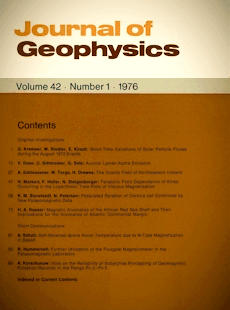Helios-1 Faraday rotation experiment: results and interpretations of the Solar occultations in 1975
Article Sidebar

Vols. 1-18 (1924-1944), ISSN 0044-2801
Main Article Content
Abstract
The polarization angle of the HELIOS-1 downlink signal has been monitored during two solar occultations in 1975 at two widely separated ground stations. Significant Faraday rotation of the signal occurs whenever the signal ray path passes through the solar corona near superior conjunction. Large-scale variations in the data arise both from rotation of the solar corona and from the slowly changing solar offset (point of smallest heliocentric distance along ray path). A simplified model of the solar corona has been developed to simulate the results of the Faraday rotation measurements. In this model the known polarity of the large-scale interplanetary magnetic field is employed as an aid in determination of the product N · B (electron density x magnetic field) as a function of heliographic longitude and heliocentric distance r within 2-10 R☉ . In this distance range N · B is proportional to r-5.5. If the magnetic field can be assumed to follow an inverse square law over this range, the electron density is found to be decreasing as r-3.5, in good agreement with previous results. The derived longitudinal structure for the corona during both occultations is consistent with synoptic coronal white light observations.
 ARK: https://n2t.net/ark:/88439/y065590
ARK: https://n2t.net/ark:/88439/y065590
Permalink: https://geophysicsjournal.com/article/112
Article Details
References
Hansen, S.F., Sawyer, C., Hansen, R.T. (1974) K corona and magnetic sector boundaries. Geophys. Res. Lett. 1:13-15
Hedgecock, P.C. (1975) The heliographic latitude dependence and sector structure of the interplanetary magnetic field 1969-1974: Results from the HEOS satellites. Solar Phys. 44:205-224
Hildner, E., Gosling, J.T., MacQueen. R.M., Munro, R.H., Poland, A.I., Ross, C.L. (1975) The large coronal transient of 10 June 1973, I: Observational description. Solar Phys. 42:163-177
Levy, G.S., Sato, T., Seidel, B.L., Stelzried, C.T., Ohlson, J.E., Rusch, W.V.T. (1969) Pioneer 6: Measurement of transient Faraday rotation phenomena observed during solar occultation. Science 166:596-598
Muhleman, D.O., Esposito, P.B., Anderson, J.D. (1977) The electron density profile of the outer corona and the interplanetary medium from Mariner-6 and Mariner-7 time-delay measurements. Astrophys.
J. 211:943-957
Neubauer, F.M., Musmann, G. (1976) Observation of magnetic sector structure and streams during the primary mission of HELIOS-1. Paper presented at Helios Project Seminar on Scientific Results, Bonn, 19-21 May
Newkirk, Jr., G. (1967) Structure of the solar corona. Ann. Rev. Astron. Astrophys. 5:213-266
Newkirk, Jr., G., Trotter, D.E., Altschuler, M.D., Howard, R. (1972) Atlas of magnetic fields in the solar corona. Solar Phys. 24:370-372
Ohlson, J.E., Levy, G.S., Stelzried, C.T. (1974) A tracking polarimeter for measuring solar and ionospheric Faraday rotation of signals from deep space probes. Trans. IEEE 23:167-177
Rosenberg, R.L. (1975) Heliographic latitude dependence of the IMF dominant polarity in 1972-1973 using Pioneer IO data. J. Geophys. Res. 80:1339-1340
Rosenberg, R.L., Coleman, Jr., P.J. (1969) Heliographic latitude dependence of the dominant polarity of the interplanetary magnetic field. J. Geophys. Res. 74:5611-5622
Schatten, K.H., Wilcox, J.M., Ness, N.F. (1969) A model of interplanetary and coronal magnetic fields. Solar Phys. 6:442-455
Severny, A., Wilcox, J.M., Scherrer, P.M., Colburn, D.S. (1970) Comparison of the mean photospheric magnetic field and the interplanetary magnetic field. Solar Phys. 15:3-14
Solar Geophysical Data (1975) 375, Nov.
Stelzried, C.T., Levy, G.S., Sato, T., Rusch, W.V.T., Ohlson, J.E., Schatten, K.H., Wilcox, J.M. (1970) The quasi-stationary coronal magnetic field and electron density as determined from a Faraday
rotation experiment. Solar Phys. 14:440-456
Stelzried, C.T., Sato, T., Abreu, A. (1972) Transformation of received signal polarization angle to the plane of the ecliptic. J. Spacecraft 9:69-70
Svalgaard, L., Wilcox, J.M. (1975) Long term evolution of solar sector structure. Solar Phys. 41:461-475
Svalgaard, L., Wilcox, J.M., Duvall, T.L. (1974) A model combining the polar and the sector structured solar magnetic fields. Solar Phys. 37:157-172











